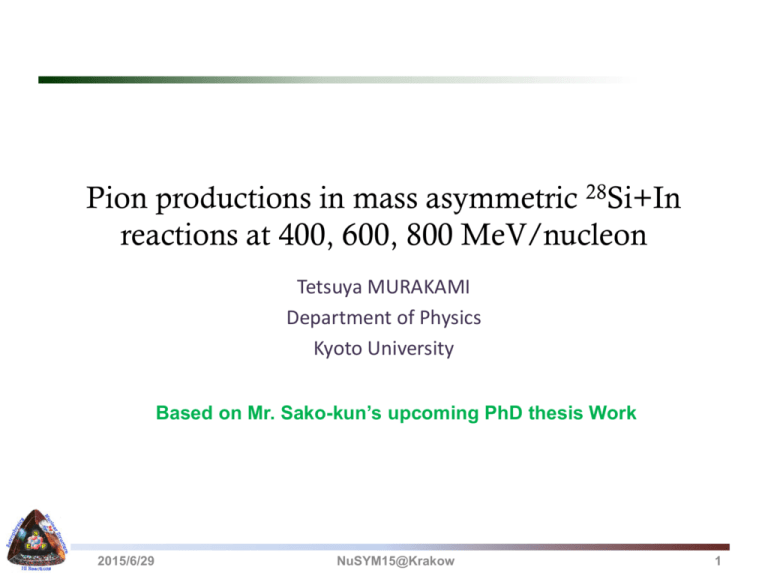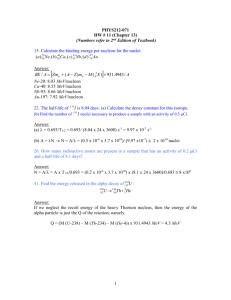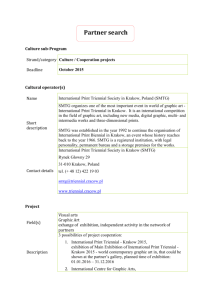Why p
advertisement

Pion productions in mass asymmetric 28Si+In reactions at 400, 600, 800 MeV/nucleon Tetsuya MURAKAMI Department of Physics Kyoto University Based on Mr. Sako-kun’s upcoming PhD thesis Work 2015/6/29 NuSYM15@Krakow 1 124 Sn 50 74 r/r0~(g+1) 2.3 @ 300 MeV/nucleon 132 Sn 50 82 (n-rich) @200~300 MeV High-density (participant region) RIBF HI Collisions Why p-/p+ ratio ? Tsang et al. Phys. Rev. C 86, 015803 (2012) The symmetry pressure in high density region of neutronrich system expels neutrons and attracts protons. Prediction of transport theory Suppress Y(n)/Y(p), Y(p-)/Y(p+), etc. Bao-An Li et al., Phys. Rev. C 71, 014608 (2005) NuSYM15@Krakow 2015/6/29 3 NN Inelastic Scattering D p •Most dominant channel for pion production •Threshold energy ~ 290 MeV in laboratory pp •p-/p+=(5N2+NZ)/(5Z2+NZ)~(N/Z)2 (D dominance model) •Cycle of pion recreation NN→NN NN→ND ND→NN D→Np Np→D Total p--p+ production ratio as a function of asymmetric parameter d NuSYM15@Krakow 2015/6/29 4 Need more information on various observables Au+Au Z. Xiao et al., PRL 102 (2009) 625 J. Xie et al., PLB 718 (2013) 1510 J. Xu et al., PRC 87 (2013) 067601 G. Ferini et al., PRL 97 (2006) 202301 Z.Q.Feng and G.-M. Jin, PLB 683 (2010) 140 J.Hong, P. Danielewicz, PRC 90 (2014) 024605 NuSYM15@Krakow 2015/6/29 5 Japanese sub-group started pion experiments using HIMAC from 2007. RI-beam >> require large acceptance Usual beam >> small acceptance may be usable NuSYM15@Krakow 2015/6/29 6 Using mass-symmetric collisions so far (N/Z)participant≈(N/Z)proj ≈(N/Z)targ Over-simplified the situation Impossible to distinguish different moving source frames, like NN cm, participant cm, nucleus-nucleus cm etc. Better study mass-asymmetric collisions NuSYM15@Krakow 2015/6/29 7 NuSYM15@Krakow 2015/6/29 8 Multiplicity Array 27-58 deg. Multiplicity Array Ion Chamber Target Beam Vacuum θlab Air Target 50cm Beam 28Si Energy(AMeV) Range Counter 400, 600, 800 132Xe 400 • Target : In ~ 390 mg/cm2 • Typical Intensity : ~ 107 ppp • Range Counter : 14 layers (+2) of Sci. • measured angle (θlab) : 30, 45, 60, 75, 90, 120 degree • solid angle : 10 msr NuSYM15@Krakow 2015/6/29 9 counter # 0 1 2 3 4 5 6 7 8 9 ・・・ 12 STOP ・ π+ decay to μ+ p+ → m+ + nμ STOP CONDITION ・μ+ : Energy ~ 4 MeV : Range ~ 1 ㎜ #0~7Hit #8~13 No Hit Double pulse in one layer ~400MeV/u Pion’s are rare less than 1/100 of protons NuSYM15@Krakow 2015/6/29 10 ch8 <π+ events> Counter #8 STOP Condition + #8 Double Hit ch7 2nd Hit Time – 1st Hit Time of ch8 stop events Fit the Histogram “2nd Hit Time -1st Hit Time” by Cexp(- t /τ) Fit curve : C*exp(- t /τ) ⇒ τ = 26.0±0.6 nsec Successfully select p+ NuSYM15@Krakow 2015/6/29 2nd Hit – 1st Hit time (nsec) 11 Using other functional form one couldn’t fit data so well so far…….. NuSYM15@Krakow 2015/6/29 12 Ebeam(MeV/nucleon) bmov(c) E0(MeV) 400 0.20(0.05) 37.0(4.3) 600 0.19(0.04) 800 0.22(0.04) N- N+ P 13.7(2.1) 0.19(0.05) 0.91(0.07) 44.1(5.0) 22.6(2.9) 0.63(0.13) 0.75(0.05) 51.8(5.1) 26.8(2.6) 1.44(0.12) 0.59(0.04) Ebeam(MeV/nucleon) sexp(p+) sexp(p-) sJQMD(p+) sJQMD(p-) 400 0.33 0.63 0.28 0.38 600 0.87 1.37 0.90 1.12 800 1.41 2.10 1.68 2.01 NuSYM15@Krakow 2015/6/29 13 At 400MeV/nucleon NuSYM15@Krakow 2015/6/29 14 400 MeV/nucleon 600 MeV/nucleon 800 MeV/nucleon Simple Coulomb effect? Ratio alone can be fitted by functional form of Maheswari et al. (NP A628 (1998) 669), but differential cross sections seem to be imposible. NuSYM15@Krakow 2015/6/29 15 NuSYM15@Krakow 2015/6/29 16 NuSYM15@Krakow 2015/6/29 17 400 MeV/nucleon 800 MeV/nucleon NuSYM15@Krakow 2015/6/29 18 Semi-analytic formula NT AT F (n , b ( 0 ) ), n RT , R p + RT b (0) b R p + RT (0) 3 1 1 - b (0) 3 1/ 2 1 - b 2 1/ 2 F (n , b ) (1 -n ) ( ) - [3(1 -n ) - 1]( ) 4 n 8 n Apart Atot F (1 / 2,b ( 0) ) (0) . NuSYM15@Krakow 2015/6/29 19 NuSYM15@Krakow 2015/6/29 20 Normalization constant: 2.02, NuSYM15@Krakow 2015/6/29 1.68, and 1.43 21 p+ associated multiplicity High multiplicity event/total event NuSYM15@Krakow 2015/6/29 22 Ebeam(MeV/nucleon) sexp(p+) sexp(p-) sJQMD(p+) sJQMD(p-) 400 0.33 0.63 0.28 0.38 600 0.87 1.37 0.90 1.12 800 1.41 2.10 1.68 2.01 Ebeam(MeV/nucleon) bmov(c) bJQMD(c) bCM(c) bpart(c) bmid(c) 400 0.20(0.05) 0.31(0.02) 0.18 0.34 0.42 600 0.19(0.04) 0.34(0.04) 0.22 0.41 0.49 800 0.22(0.04) 0.35(0.06) 0.26 0.46 0.55 NuSYM15@Krakow 2015/6/29 23 Measured doubly differential cross sections of p+ and p- for the 28Si + In reactions at 400, 600 and 800 MeV/nucleons. They are emitted isotropically from the single moving source, whose velocity is quite slower than the mid rapidity. The differential pion ratios represented in such moving frames overlap each other at each incident energy. PHITS fails to reproduce the observed absolute cross section, the angular dependence of the cross sections and the charged pion ratio. NuSYM15@Krakow 2015/6/29 24 Collaborator M, Sako1;2, T, Murakami1;2, Y, Nakai2, Y. Ichikawa1, K. Ieki3, S. Imajo1, T. Isobe2, M. Matsushita3, J. Murata3, S. Nishimura2, H. Sakurai2, R.D. Sameshima1, E. Takada4, 1. Kyoto University 2. Riken 3. Rikkyo University 4. NIRS NuSYM15@Krakow 2015/6/29 25 NuSYM15@Krakow 2015/6/29 26 NuSYM15@Krakow 2015/6/29 27








